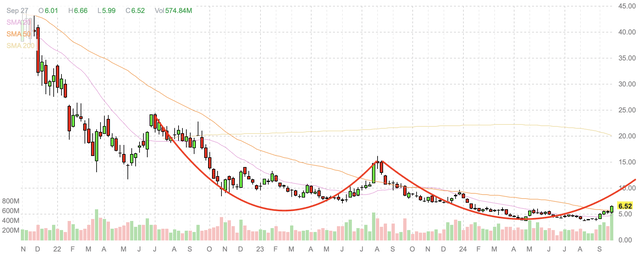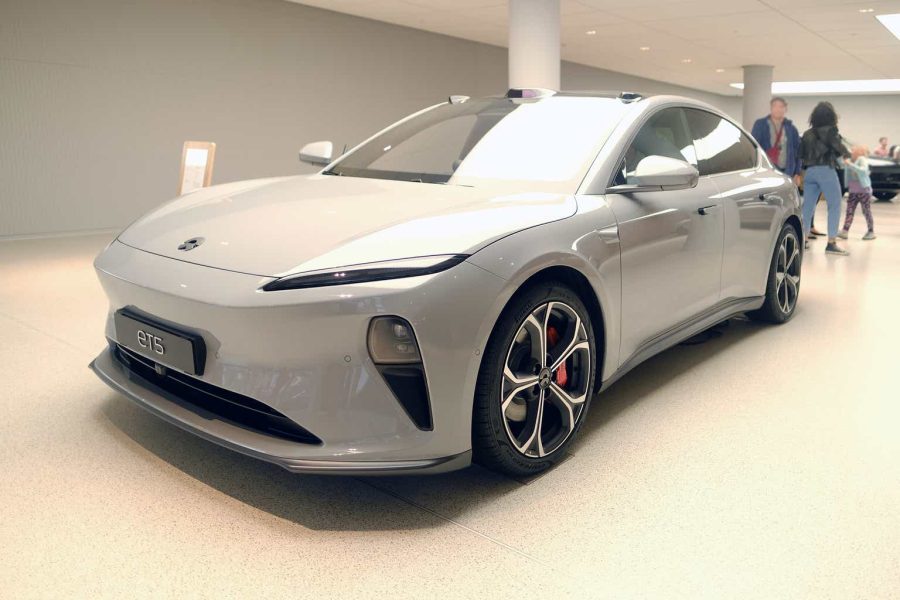Summary:
- NIO shares broke out of a long-term downtrend and are poised for significant near-term appreciation due to Chinese market revaluation and a new brand launch.
- NIO’s growth is driven by increasing vehicle deliveries, battery-as-a-service plans, and international expansion, despite ongoing margin pressures and expected losses due to expansion costs.
- The Onvo sub-brand and battery-as-a-service subscription plans could become major value drivers, offering affordable vehicles and more predictable revenue streams.
- Risks include intense EV market competition, potential logistical issues with battery services, and international expansion challenges due to tariffs and local market resistance.
Victor Golmer
NIO (NYSE:NIO) shares look ready to quickly accelerate up the chart. After a prolonged period of declining that started back in 2021, NIO appears to be ready to revalue higher. Despite the fact that NIO is likely to remain under margin pressure and sustain losses for the next few years, the company continues to grow its unit sales and revenue numbers, and should be expected to do so for the foreseeable future. As that growth occurs, economies of scale are likely to help NIO reduce its costs and realize greater operating margins. Nonetheless, the primary reason NIO is likely to appreciate in the near term is due to macro forces that are revaluing Chinese equities higher.
NIO continues to grow at a fast pace. Management’s guidance for 3Q vehicle deliveries expects 10% to 14% year-over-year growth to 61,000-63,000 vehicles. NIO’s revenue is expected to be relatively flat to potentially increase three percent, which is due to price reductions.
NIO has become a market leader in battery swap technology, which may be seen as both an alternative and a supplement to battery charging. Moreover, NIO’s battery-as-a-service subscription plans essentially lower the price of its vehicles by removing the battery from the cost. Removing the cost of a battery from the vehicle reduces the upfront purchase price of NIO’s vehicles by up to 30 percent.
NIO is likely to continue to have losses over the next few years due to existing incentives, costs associated with the rollout of battery swapping facilities, as well as charging stations, and costs associated with its international business expansion. NIO plans on building over 4,000 swap worldwide stations by 2025, with about 1,000 being located in markets other than China. NIO has been expanding into European markets, including Denmark, Germany, Sweden, and the Netherlands.
NIO has established itself as a premium EV brand in China, and has the potential to do so in other markets over time. Neo also recently developed a sub-brand, Onvo, which just began deliveries of its first model, the L60, in China. Like with NIO vehicles, the L60 is being sold with a battery rental option, with a monthly subscription price that depends upon the battery pack size. NIO anticipates that L60 deliveries should ramp through the end of 2024, and potentially reach 10,000 units in December, and targets 20,000 vehicles delivered per month in 2025. These numbers are substantial given that, in total, NIO sold about 21,000 vehicles this month.
In early September, NIO broke out of a long-term downtrend. This breakout recently gained momentum along with most of the Chinese market. Despite the strong move up by about 60 percent over the last month, shares are still down by about 20 percent for the year.
NIO daily candlestick chart (Finviz.com)
NIO still has the potential to substantially increase from current levels. Even in its pre-existing downtrend, NIO would sometimes spike higher. Now, though, the company is launching a whole new brand, plus the Chinese market is revaluing higher. These catalysts have the potential to power a more substantial revaluation.
NIO weekly candlestick chart (Finviz.com with red lines by Zvi Bar)
If the Onvo brand becomes successful, it has the potential to become a meaningful driver of value. Onto vehicles will service a lower price point, and therefore have a larger total addressable market. This is part of the reason that NIO anticipates Onvo’s volumes being as high as NIO’s by next year, even though it only started deliveries in September.
Similarly, NIO’s battery-as-a-service plans create the potential for a new mechanism of valuing the equity. Markets like subscription services because they create recurring revenue streams that are easier to predict than are sales volumes. As NIO grows is battery-as-a-service rental plans, it should be expected that analysts will come to appreciate these plans and provide NIO with a greater multiple than they otherwise would.
NIO is a potential short squeeze candidate. The company currently has about 9.2% of outstanding shares sold short, according to Seeking Alpha. This short position indicates that many investors do not have faith in NIO’s stock performance. One probable reason for this would be the expected costs associated with developing Onvo. Whatever the reason was, many of these short shares may have to soon close that position due to the spiking price of NIO shares. The closing of such short positions requires those who sold shares short to buy shares, which means that these shorts are potential near-term buyers of NIO, and that their need to close out their position should only increase as NIO’s stock price does. Given this relatively high percentage of shares sold short, NIO should be considered a short squeeze candidate.
Risks
The EV market is highly competitive. Even though NIO is developing a reasonably strong name for itself, it is not a longstanding and established brand. NIO’s position as a premium EV maker could also be lost over time.
NIO’s battery-as-a-service plans could end up running into logistical issues and costs that make them unprofitable and impracticable. Further, this distinction adds another level of uncertainty that analysts may not like until it is proven, as there are no comps upon which to value that business model. NIO is also incurring significant costs associated with developing its battery-as-a-service business, as well as ramping production within the Onvo sub-brand.
NIO’s international expansion could run into growing headwinds in the form of increased tariffs and other maneuvers aimed at stifling Chinese competition in local markets.
Conclusion
NIO has been in a sustained downtrend for the last few years, but it just broke out and appears primed to increase in the near term. I believe that NIO has the potential to substantially increase over the next several months and quarters, and this recent uptrend is unlikely to stop before NIO is in the double digits.
The primary catalyst for a sustained uptrend is that recently announced Chinese stimulus is a rising tide that should lift all Chinese boats, including NIO. A secondary catalyst is that NIO’s sub-brand, Onvo, recently began delivering vehicles and has the potential to become a successful brand with greater sales volumes than the NIO already has. A third potential catalyst is that its battery-as-a-service subscription plans could become a successful differentiator that makes its vehicles more affordable upfront, and also create a recurring revenue stream that markets come to appreciate. Finally, NIO has a significant number of shares sold short against it. On a short squeeze, NIO shares could easily increase to $10 or greater in short order.
Analyst’s Disclosure: I/we have a beneficial long position in the shares of NIO either through stock ownership, options, or other derivatives. I wrote this article myself, and it expresses my own opinions. I am not receiving compensation for it (other than from Seeking Alpha). I have no business relationship with any company whose stock is mentioned in this article.
Seeking Alpha’s Disclosure: Past performance is no guarantee of future results. No recommendation or advice is being given as to whether any investment is suitable for a particular investor. Any views or opinions expressed above may not reflect those of Seeking Alpha as a whole. Seeking Alpha is not a licensed securities dealer, broker or US investment adviser or investment bank. Our analysts are third party authors that include both professional investors and individual investors who may not be licensed or certified by any institute or regulatory body.
